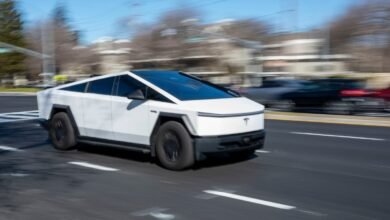Tesla’s Sales Surge May Be Short-Lived

▼ Summary
– Tesla’s quarterly sales increased for the first time this year, driven by consumers rushing to use expiring federal EV tax credits before September 30th.
– The company delivered 497,099 vehicles in Q3, a 7.4% increase from the same quarter in 2024, while production decreased by 5% to 447,450 vehicles.
– Tesla faces declining sales in Europe (down 37% year-to-date) and China due to rising competition from domestic manufacturers like BYD and Geely.
– Experts predict US EV sales will drop after the tax credit expires, with Elon Musk anticipating “a few rough quarters” before a potential rebound from AI initiatives like robotaxis.
– Tesla is proposing a new pay package for Musk tied to ambitious milestones, including producing millions of robots and robotaxis, while shifting focus from EVs to AI and robotics in its Master Plan.
Tesla’s recent quarterly sales figures show a welcome uptick, largely driven by consumers eager to secure a $7,500 federal EV tax credit before its expiration on September 30th. This surge in demand helped the company report delivering 497,099 vehicles, a notable increase compared to the same period last year. However, a closer look reveals a more complex and challenging picture for the electric vehicle pioneer.
Between July and September, Tesla manufactured 447,450 vehicles. The overwhelming majority of these were Model 3 and Model Y units, with a smaller number comprising the Model S, Model X, and the Cybertruck. Interestingly, this production figure actually represents a 5 percent decline from the third quarter of the previous year. The fact that the company delivered approximately 50,000 more vehicles than it produced indicates a successful effort to reduce the excess inventory that had been accumulating throughout the first half of the year.
While the U.S. market provided a temporary lift, Tesla’s international performance tells a different story. The situation in Europe is particularly difficult, with sales down a significant 37 percent year-to-date. In China, the world’s largest EV market, the company faces intense pressure from local competitors like BYD and Geely, contributing to an ongoing sales slump in the region.
This sales boost is likely to be short-lived. Industry analysts anticipate a sharp decline in U.S. electric vehicle sales now that the influential tax incentive is no longer available. Elon Musk himself has cautioned that Tesla is facing “a few rough quarters” ahead, citing the expired credit and broader economic headwinds. He pins the company’s long-term recovery on the success of its ambitious artificial intelligence projects, which include a future fleet of robotaxis and humanoid robots. Musk has made bold predictions, stating that half of the U.S. population will have access to Tesla’s robotaxi service by the end of 2025, though the service is currently limited to just Austin and San Francisco.
The sales report coincides with a proposed new compensation package for Musk that could potentially make him the world’s first trillionaire. To earn this historic payday, he would need to achieve a series of staggering milestones, such as producing over one million robots, launching one million robotaxis, and generating $7.5 trillion in value for shareholders. A special shareholder meeting is scheduled for November 6th to vote on this proposal.
In a show of confidence, Musk recently purchased $1 billion worth of Tesla stock, marking his first open-market buy in over five years. This move follows the recent unveiling of an updated Master Plan that signals a strategic pivot for the company, shifting focus away from its core electric vehicle business toward a future dominated by AI and robotics.
Despite these futuristic ambitions, the promised technologies are likely years from widespread reality, leaving Tesla to navigate the immediate challenges of an aging vehicle lineup and a brand image that has taken some hits. The company has mentioned plans for a more affordable version of its popular Model Y, initially slated for volume production in the latter half of 2025, but specific details and a firm timeline remain unclear.
(Source: The Verge)





